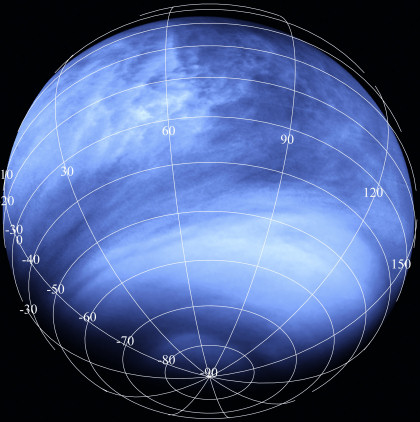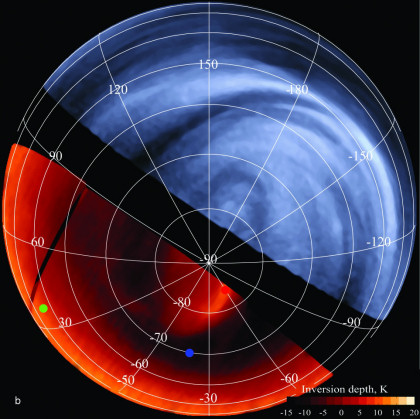Press Release 17 - 4th December 2008
A closer look at Venus' veil
Scientists from the Max-Planck-Institute for Solar System Research discover the processes that shape the clouds on Venus.
The veil of clouds made mainly from sulfuric acid that enshrouds Venus has been puzzling scientists for decades. Until now the physical processes responsible for the formation of the global cloud pattern were poorly understood and even the altitude of the clouds was not known.Together with an international team of scientists, researchers from the Max Planck Institute for Solar System Research (MPS) in Germany have now discovered the processes in the planet’s atmosphere that are responsible for the appearance and morphology of the clouds. With the help of instruments aboard ESA’s Venus Express orbiter they could show, that temperature conditions and dynamics play an important role.
Venus is surrounded by a dense atmosphere. However unlike on Earth, it consists mainly of toxic gases such as carbon dioxide and various sulfur compounds. The clouds, for example, are mainly made of tiny droplets of sulfuric acid. In addition they contain an aerosol that scientists have not yet been able to identify.
This unknown material plays a key role in the imaging of Venus’ clouds. Since it strongly absorbs ultraviolet light, images taken in this spectral range show a global contrast pattern: Where the image is dark, the unknown absorber is highly concentrated at the cloud tops. Bright regions correspond to a low abundance of the ultraviolet absorber. However taken alone, ultraviolet images cannot explain the physical processes that influence the clouds. Even their altitude was not known.

|
Figure 1: Venus Monitoring Camera ultraviolet image taken from a distance of about 30000 kilometers. It shows numerous high-contrast features caused by an unknown aerosol in the clouds that absorbs ultraviolet light, creating the bright and dark zones.
|
(Image: ESA/MPS/DLR/IDA)
|
"Earlier missions to Venus could only analyze limited parts of the light, that the planet reflects and emits into space", explains Dr. Dmitry Titov from MPS. Scientists could, for example, either observe the cloud pattern in ultraviolet light or derive the air temperature from the infrared radiation. But since these observations were always carried out separately, they could not be related to each other.
With its Venus Monitoring Camera ( VMC) and the Italian-French infrared spectrometer VIRTIS
VMC) and the Italian-French infrared spectrometer VIRTIS  Venus Express for the first time offers the possibility to detect these different wavelengths simultaneously. Therefore, in their new study scientists from MPS were able to investigate the temperature and dynamical conditions on Venus and study their relation to the global cloud pattern.
Venus Express for the first time offers the possibility to detect these different wavelengths simultaneously. Therefore, in their new study scientists from MPS were able to investigate the temperature and dynamical conditions on Venus and study their relation to the global cloud pattern.
Spectral data show that above the Venus tropics the air temperature strongly decreases with altitude. This leads to vigorous up winds that tear the clouds apart and brings absorbers from the depths. In the middle latitudes the conditions change drastically: The temperature profile is inverted resulting in a vast annulus of cold air circling the planet at middle latitudes nick-named the "cold collar". This annulus suppresses the up winds thus cutting of the supply of the ultraviolet absorber to the cloud tops. The UV-images of this region are therefore bright and uniform corresponding to a featureless sulfuric acid haze.

|
Figure 2: Venus at ultraviolet and infrared wavelengths. The lower left shows a map of temperature inversion at the Venus cloud tops derived from the VIRTIS spectrometer on the planet’s night-side. Dark regions correspond to cold cloud tops. The upper right is an ultraviolet image of the Venusian day side, captured simultaneously by the Venus Monitoring Camera.
|
(Image: ESA/VMC/VIRTIS)
|
The new data also permits to determine the exact altitude of the cloud tops above the southern hemisphere. Despite completely different conditions in the tropics and at middle latitudes, the clouds in both regions are found at 72 kilometers above the surface. Only at the south pole cloud top altitude sinks to about 64 kilometers forming a kind of huge whirlpool. "We can now accurately assign the wind speeds that we determine from the motion of cloud features to a certain altitude", explains Titov. The new study will therefore make it possible to track the weather on Venus more closely.
The Venus Express spacecraft was launched by ESA on November 9th, 2005. For almost three years now, it has been circling the planet. The Venus Monitoring Camera aboard the spacecraft was developed and built by the Max Planck Institute for Solar System Research, the Institute of Planetary Research/DLR, and the Institute of Computer and Communication Network Engineering/TU Braunschweig.
Further Information
 Venus-Express at MPS
Venus-Express at MPS
Original Publication
D. V. Titov, F.W. Taylor, H. Svedhem, N.I. Ignatiev, W.J. Markiewicz, G. Piccioni, and P. Drossart
Atmospheric structure and dynamics as the cause of ultraviolet markings in the clouds of Venus
Nature, December 4th 2008
Contact
Dr. Birgit Krummheuer
Public Relations, Press Officer
Max-Planck-Institut für
Sonnensystemforschung
Max-Planck-Straße 2
37191 Katlenburg-Lindau
Tel.: +49 5556 979 462
Mobil: +49 173 39 58 625
Fax.: +49 5556 979 240
Email: Krummheuer@mps.mpg.de
Dr. Dimiti V. Titov
Max-Planck-Institut für
Sonnensystemforschung
Max-Planck-Straße 2
37191 Katlenburg-Lindau
Tel.: +49 5556 979 212
Fax.: +49 5556 979 240
Email: titov@mps.mpg.de
Dr. Wojciech J. Markiewicz
Max-Planck-Institut für
Sonnensystemforschung
Max-Planck-Straße 2
37191 Katlenburg-Lindau
Tel.: +49 5556 979 294
Fax.: +49 5556 979 240
Email: markiewicz@mps.mpg.de
